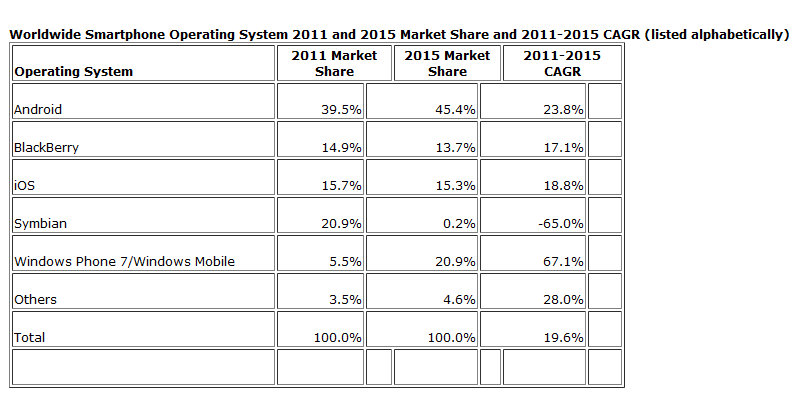Four reasons why IDC's 2015 Nokia-Microsoft predictions are bunk

IDC's outlook for the smartphone industry in 2015 has Microsoft's Windows Phone 7 the No. 2 operating system behind Android. Microsoft's global surge will come via its partnership with Nokia.
Here's the money chart for IDC's somewhat cracked crystal ball:
In a nutshell, IDC is assuming that all Nokia users will stay loyal to the brand and become Windows Phone 7 users.
Up until the launch of Windows Phone 7 last year, Microsoft has steadily lost market share while other operating systems have brought forth new and appealing experiences. The new alliance brings together Nokia's hardware capabilities and Windows Phone's differentiated platform. We expect the first devices to launch in 2012. By 2015, IDC expects Windows Phone to be number 2 operating system worldwide behind Android.
So how is Windows Phone OS going to catapult to No. 2 in four years? If you look at IDC’s chart, it will largely happen by picking up almost all the Symbian share, according to IDC. IDC is predicting the 20.9 percent Symbian share will be down to .2 percent by 2015. I’m sure Microsoft is counting on getting a hefty share boost from its $1 billion-plus investment in Nokia, but will the Softies manage to hold onto almost all the Symbian base, as Nokia tries to wean them from Symbian? I’d think, given some Nokia users’ skepticism about the sanity of the deal, more than a few might go Android or iOS.
Indeed, IDC's projections are bunk. For starters, the smartphone industry is moving too fast to make predictions for 2015. But there are a lot of other reasons to question IDC's assumptions for 2015. Here are four:
- Nokia isn't likely to hold smartphone share. Let's see Nokia won't have a barrage of Windows Phone 7 phones in the market until 2012. Nokia is essentially taking a year off while other handset makers (Samsung, HTC, RIM, Apple, Motorola) keep pumping out smartphones. Nokia is a no-show in the U.S. and its possible that folks that leave the handset maker in 2011 may not come back.
- Windows Phone 7 may not appeal to all Symbian users. How do you assume that most Symbian users will go to Microsoft? Because Nokia says so? The logic doesn't work. Symbian users are likely to watch iOS, RIM's QNX and Android too. Peer pressure may play a role also.
- The smartphone industry moves at light speed and four years is an eternity. Any projection beyond 2012 is suspect to me. Four years ago no one saw Apple's iOS coming. Android didn't exist.
- IDC's projection assumes near flawless execution. If Nokia's timetables slip for Windows Phone 7 devices, it will have to close a larger market share gap by 2015. On the other side, Microsoft has to show it can evolve Windows Phone 7. Neither partner can run in place. More than 20 percent market share in 2015 is aggressive.
Related:
- Nokia and Microsoft: Economics, risks of a 2-year transition to Windows Phone 7
- IDC predicts Windows Phone 7 will be 2nd behind Android by 2015
- Nokia: Work has begun on Windows Phone handsets
- Nokia: Transition to Windows Phone to take about two years
- Microsoft-Nokia deal is like two fading marathon runners deciding to hold hands
- Nokia to rely on Microsoft's Windows Phone 7: 'This is now a three horse race'
